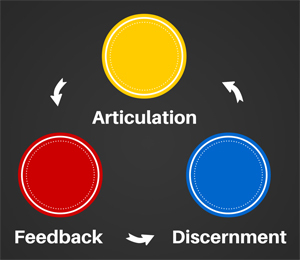Got an idea?
Great. But now what? Do you just go off and build it? Hire staff, buy stock, build software? Dangerous stuff, my friend.
Ask any successful entrepreneur if they ended up changing their initial idea and 9 times out of 10, what do you find? They not only changed it, they evolved it beyond measure. Hard to see where they even began.
The point for you? Don't marry your initial idea. Early ideas are just stepping stones to better ideas. After a ton of chaos, conversations and testing, a successful entrepreneur ends up with a viable idea that wins.
Jack Dorsey, Evan Williams, Noah Glass and Biz Stone, cofounders of Twitter, took the idea from a text message-based system for broadcasting status updates, to an information network. Along the way, they had countless ideas on where to take it. And they constantly peppered users with questions on what they liked and didn't like. Most ideas never went anywhere. A few, like hashtags, search and retweets, thrived and added a ton of value.
So how do you do this? How do you go from bad to better? Three steps.
Articulation
You need other people to get anything off the ground. So your idea needs to be clear in your head to begin with.
If you can't get it into the heads of the right people--potential customers, mentors, partners--then you have nothing. An idea with abysmal communication has zero value. It doesn't exist.
Well-articulated ideas are short, precise, relevant and tell the customer about benefits, not just features. They don't take too long to say, they're specific enough to get the thing into the other person's mind, written in language your customer understands--and critically, they tell you what it does for you, not just what it is.
Let's say you have an idea for a service to help bloggers find sources for their material. They send you their blog posts, pay you a certain amount, and you or your staff go and find the best source material you can for them. That's the idea.
And it's a mouthful. How can we articulate it better?
You cut it down, keep it precise enough, use their own language and emphasize benefits over features. So: a low-fee service to help bloggers save time by fetching them credible sources. Much better.
Feedback
You have a well-articulated idea. Next step? Get it out there and see what people say.
What kind of people? Too many entrepreneurs have an idea, then go ask their friends, loved ones and acquaintances what they think of it. But unless those are your potential customers, why do you care what they think? You're not after them. They speak a different language and likely won't 'get it'.
You should ask the market, or people who spent time in the market. That means potential customers or mentors who've cut their teeth in the same niche. Those people matter. Don't underestimate this: if you restrict yourself to people with no connection to your target market, you risk killing a potentially great idea. Hard to ignore negative feedback.
So go ask the market. How do you do that? Simple: figure out where your target customers hang out, pick a few individuals and put your idea into play.
Take the blogger example again. You got the idea, and you find a blogger guy called Rob from his Twitter profile. So you reach out. The conversation might go like this:
"Hey Rob. Just found your blog via Twitter. I see you've previously written about how much time you waste trying to find sources for posts. Is that still a problem? How much so?"
And Rob agrees--yes, a real hassle.
"Okay, what if you had a low-fee service that saves you time by fetching solid, credible sources for you? How would that help?"
And there you go--your idea is in motion. You now step away and see what happens with Rob, if anything. Repeat this a number of times; find more bloggers who have or might have this problem. Collect all that feedback and make it readable. You need to be able to see patterns at a glance.
Discernment
This part is magic. You take all you've learned--from your conversations with customers and mentors, plus your own thinking and research--and figure out where to go next. You either kill the idea or change it.
And if you do change it, you loop back to Articulation and start over.
In our blogger example, let's say you reached out to 10 bloggers. All agree it's a real problem. Around half say your service would help, but a far bigger problem is finding good topics to write about. Only one person says your idea is great and they'd pay for your service.
What does that tell you? You might be on to something with the premise--bloggers might pay for a service to help them in some way. But your angle is off--they won't pay you for finding sources. So what do you do? You change your idea: now you're thinking of a paid service to help bloggers find the best topics to write about. To get them more traffic and ad revenue.
You now have an improved version of your initial idea. Where do you go from here? Can you just go chase it?
Wait though. Truth is, your idea needs constant development. Yes, at some point you need to execute. Build some small product or service. But the underlying idea always needs development. So you need to loop back all the way to Articulation.
You see how this works? Constant iteration. Each step makes your idea sharper and more relevant to the market.
The bottom line about ideas? Start with a dud, turn it into a killer. You can do it.
Hi, I'm Harry. Keen to build technology to help you discover ideas that work--to save you time and tears. Let's connect.

